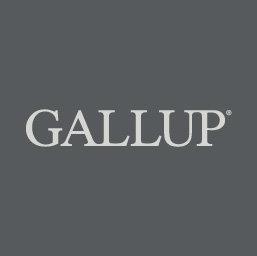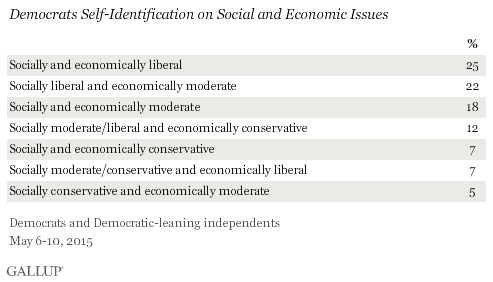
Democrats in the U.S. Shift to the Left
Story Highlights
- 47% of Democrats are socially liberal and economically moderate/liberal
- This is up 17 percentage points since 2001
- Democrats remain more liberal on social than on economic issues
PRINCETON, N.J. -- Democratic candidates for the 2016 presidential nomination face a significantly more left-leaning party base than their predecessors did over the last 15 years. Forty-seven percent of Democrats and Democratic-leaning independents now identify as both socially liberal and economically moderate or liberal. This is compared with 39% in these categories in 2008, when there was last an open seat for their party's nomination, and 30% in 2001.

This combined group of Democrats consists of 25% who are pure liberals -- identifying as liberal on both social and economic issues -- and 22% who are social liberals but moderate on the economy. At the other end of the ideological spectrum, a scant 7% of Democrats are socially and economically conservative. Most of the rest of Democrats have more mixed ideological leanings, with 18% moderate on both social and economic issues, and 12% socially moderate or liberal but economically conservative.

These data are from Gallup's annual Values and Beliefs poll, which since 2001 has included questions asking Americans to rate themselves as conservative, moderate or liberal on social and economic issues. The trends for the entire country show a shift toward more liberal self-identification, and that trend is even more pronounced among Democrats on social issues. More than half of Democrats (53%) describe themselves as socially liberal at this point, up from 35% in 2001. On the economic front, Democrats remain most likely to say they are moderate, but among the rest who don't call themselves moderate, economically liberal has become a more frequent self-label than economically conservative.
Implications
Americans' perceptions of their social and economic views on the ideological spectrum are quite general, and such labels don't always translate directly into specific policy and issues positions. Ideological labels, however, are helpful in understanding voters' positioning in the election year to come. The shift leftward appears to fit with trends on very specific issues such as same-sex marriage.
Primary voters can vary from state to state, but broadly these national trends broadly suggest that Democratic candidates can be somewhat more left-leaning in their policy and issue prescriptions in the 2016 election campaign than in the past.
Democratic front-runner Hillary Clinton faces a more liberal base than she did when she last ran for president in 2008, and no doubt will be calibrating her positions accordingly. The shift in the electorate may help explain the attention being garnered by long-shot candidate Sen. Bernie Sanders of Vermont who has used the label "socialist" to describe himself and who is avowedly liberal across the board. Two other announced Democratic candidates -- former Maryland Gov. Martin O'Malley and former Republican senator from Rhode Island Lincoln Chafee -- have taken liberal positions in the past. In the 2016 election, they will be seeking to connect with the electorate on that basis, while also attempting to position themselves against Clinton on specific issues.
One consideration for Democratic candidates is the fact that their party's base is somewhat more liberal on social issues than on economic issues, suggesting that candidates may need to temper their liberalism on the economy a little more than they do on their social positions.
A second consideration for Democrat candidates, as always, is the need to be sensitive to the general election demands should they win their party's nomination. While 47% of their party base is socially liberal and either moderate or liberal on the economy, that same percentage among Republicans and Republican independents is only 7%, and some votes from the GOP will be necessary to win in November 2016.
Survey Methods
Results for this Gallup poll are based on telephone interviews conducted May 6-10, 2015, with a random sample of 1,024 adults, aged 18 and older, living in all 50 U.S. states and the District of Columbia. For results based on the total sample of national adults, the margin of sampling error is ±4 percentage points at the 95% confidence level. All reported margins of sampling error include computed design effects for weighting.
Each sample of national adults includes a minimum quota of 50% cellphone respondents and 50% landline respondents, with additional minimum quotas by time zone within region. Landline and cellular telephone numbers are selected using random-digit-dial methods.
Learn more about how Gallup Poll Social Series works.
